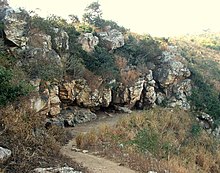| Revision as of 14:07, 4 August 2018 editPriyal Chandima (talk | contribs)2 edits ←Replaced content with 'ප්රථම ධර්ම සංගායනාව'Tag: Replaced← Previous edit | Revision as of 14:07, 4 August 2018 edit undoClueBot NG (talk | contribs)Bots, Pending changes reviewers, Rollbackers6,439,588 editsm Reverting possible vandalism by Priyal Chandima to version by 82.27.90.157. Report False Positive? Thanks, ClueBot NG. (3440459) (Bot)Tag: RollbackNext edit → | ||
| Line 1: | Line 1: | ||
| __NOTOC__ | |||
| ප්රථම ධර්ම සංගායනාව | |||
| ], painting at the Nava Jetavana, Shravasti]] | |||
| {{EarlyBuddhism}} | |||
| The '''First Buddhist council''' was a gathering of senior monks of the Buddhist order convened just after ] death in ca. 400 BCE.<ref>Harvey, Peter (2013). ''An Introduction to Buddhism: Teachings, History and Practices (2nd ed.).'' Cambridge, UK: Cambridge University Press. pg. 88.</ref><ref>{{Cite book|url=http://www.worldcat.org/oclc/33669718|title=When did the Buddha live?: the controversy on the dating of the historical Buddha|date=1995|publisher=Sri Satguru Publications|isbn=8170304695|editor-last=Bechert|editor-first=Heinz|location=Delhi, India|language=English|editor-last2=Akademie der Wissenschaften in Göttingen}}</ref> The story of the gathering is recorded in the ] of the ] and Sanskrit Buddhist schools. It is regarded as canonical by all schools of Buddhism, but in the absence of evidence from outside the Buddhist sutras some scholars have expressed doubts as to the event's historicity.<ref>{{Cite web|url=http://www.sacred-texts.com/journals/mon/1stbudcn.htm|title=The First Buddhist Council|website=www.sacred-texts.com|access-date=2017-12-30}}</ref> | |||
| ==Description== | |||
| ] in ], where the First Buddhist Council may have been held.]] | |||
| A council of 500 ] was held at ] (Sanskrit: Rājagṛha) three months following the Buddha's death to agree on the contents of the Dhamma and Vinaya.<ref>Harvey, Peter (2013). ''An Introduction to Buddhism: Teachings, History and Practices (2nd ed.).'' Cambridge, UK: Cambridge University Press. pg. 88.</ref><ref>{{Cite web|url=https://www.buddhanet.net/e-learning/buddhism/lifebuddha/2_32lbud.htm|title=Life of Buddha: The 1st Buddhist Council (Part 2)|website=www.buddhanet.net|access-date=2017-12-30}}</ref> It is said that following the Buddha's death, 499 of the Buddha's top arahats were chosen to attend the council, with one seat reserved for ], then a ]. As the meeting approached, Ananda trained himself until the dawn of day of the council. When the dawn arrived, he decided to lie down and before his head hit the pillow he became an arahant.<ref>{{Cite web|url=https://www.buddhanet.net/e-learning/buddhism/lifebuddha/2_32lbud.htm|title=Life of Buddha: The 1st Buddhist Council (Part 2)|website=www.buddhanet.net|access-date=2017-12-30}}</ref> | |||
| The meeting was led by ] under the patronage of the king ]. Its objective was to preserve the Buddha's sayings (]) and the monastic discipline or rules (]). Even though the Buddha allowed the Sangha to abolish the minor rules, the ] made the unanimous decision to keep all the rules of the Vinaya. ] recited the Suttas, such that each begins: ‘Thus have I heard’ (Pali: ''Evaṃ me sutaṃ'').<ref>Harvey, Peter (2013). ''An Introduction to Buddhism: Teachings, History and Practices (2nd ed.).'' Cambridge, UK: Cambridge University Press. pg. 88.</ref> The monk ] (Sanskrit उपालि upāli) recited the Vinaya.<ref>Harvey, Peter (2013). ''An Introduction to Buddhism: Teachings, History and Practices (2nd ed.).'' Cambridge, UK: Cambridge University Press. pg. 88.</ref> According to D.N. commentary's introduction, the ] and ancient commentary was also included. | |||
| ==See also== | |||
| *] | |||
| *] | |||
| *] | |||
| *] | |||
| *] | |||
| *] | |||
| ==External Links== | |||
| * (English translation) - The traditional story of the First Council, as recorded in the ]. | |||
| ==References== | |||
| {{reflist}} | |||
| ==Bibliography== | |||
| *Harvey, Peter (2013). ''An Introduction to Buddhism: Teachings, History and Practices (2nd ed.).'' Cambridge, UK: Cambridge University Press. | |||
| {{Buddhism topics}} | |||
| ] | |||
| ] | |||
| ] | |||
| ] | |||
| ] | |||
Revision as of 14:07, 4 August 2018

| Part of a series on |
| Early Buddhism |
|---|
 |
| Buddhism |
Scriptures
|
| Early sangha |
| Pre-sectarian Buddhism |
Early Buddhist schools
|
| Terms |
The First Buddhist council was a gathering of senior monks of the Buddhist order convened just after Gautama Buddha's death in ca. 400 BCE. The story of the gathering is recorded in the Vinaya Pitaka of the Theravadins and Sanskrit Buddhist schools. It is regarded as canonical by all schools of Buddhism, but in the absence of evidence from outside the Buddhist sutras some scholars have expressed doubts as to the event's historicity.
Description

A council of 500 Arahats was held at Rajgir (Sanskrit: Rājagṛha) three months following the Buddha's death to agree on the contents of the Dhamma and Vinaya. It is said that following the Buddha's death, 499 of the Buddha's top arahats were chosen to attend the council, with one seat reserved for Ananda, then a sotapanna. As the meeting approached, Ananda trained himself until the dawn of day of the council. When the dawn arrived, he decided to lie down and before his head hit the pillow he became an arahant.
The meeting was led by Mahakasyapa under the patronage of the king Ajatashatru. Its objective was to preserve the Buddha's sayings (suttas) and the monastic discipline or rules (Vinaya). Even though the Buddha allowed the Sangha to abolish the minor rules, the Sangha made the unanimous decision to keep all the rules of the Vinaya. Ananda recited the Suttas, such that each begins: ‘Thus have I heard’ (Pali: Evaṃ me sutaṃ). The monk Upali (Sanskrit उपालि upāli) recited the Vinaya. According to D.N. commentary's introduction, the Abhidhamma Pitaka and ancient commentary was also included.
See also
- Buddhist councils
- Second Buddhist council
- Third Buddhist council
- Fourth Buddhist council
- Fifth Buddhist council
- Sixth Buddhist council
External Links
- Recitation of the Five Hundred (English translation) - The traditional story of the First Council, as recorded in the Pali Canon.
References
- Harvey, Peter (2013). An Introduction to Buddhism: Teachings, History and Practices (2nd ed.). Cambridge, UK: Cambridge University Press. pg. 88.
- Bechert, Heinz; Akademie der Wissenschaften in Göttingen, eds. (1995). When did the Buddha live?: the controversy on the dating of the historical Buddha. Delhi, India: Sri Satguru Publications. ISBN 8170304695.
- "The First Buddhist Council". www.sacred-texts.com. Retrieved 2017-12-30.
- Harvey, Peter (2013). An Introduction to Buddhism: Teachings, History and Practices (2nd ed.). Cambridge, UK: Cambridge University Press. pg. 88.
- "Life of Buddha: The 1st Buddhist Council (Part 2)". www.buddhanet.net. Retrieved 2017-12-30.
- "Life of Buddha: The 1st Buddhist Council (Part 2)". www.buddhanet.net. Retrieved 2017-12-30.
- Harvey, Peter (2013). An Introduction to Buddhism: Teachings, History and Practices (2nd ed.). Cambridge, UK: Cambridge University Press. pg. 88.
- Harvey, Peter (2013). An Introduction to Buddhism: Teachings, History and Practices (2nd ed.). Cambridge, UK: Cambridge University Press. pg. 88.
Bibliography
- Harvey, Peter (2013). An Introduction to Buddhism: Teachings, History and Practices (2nd ed.). Cambridge, UK: Cambridge University Press.